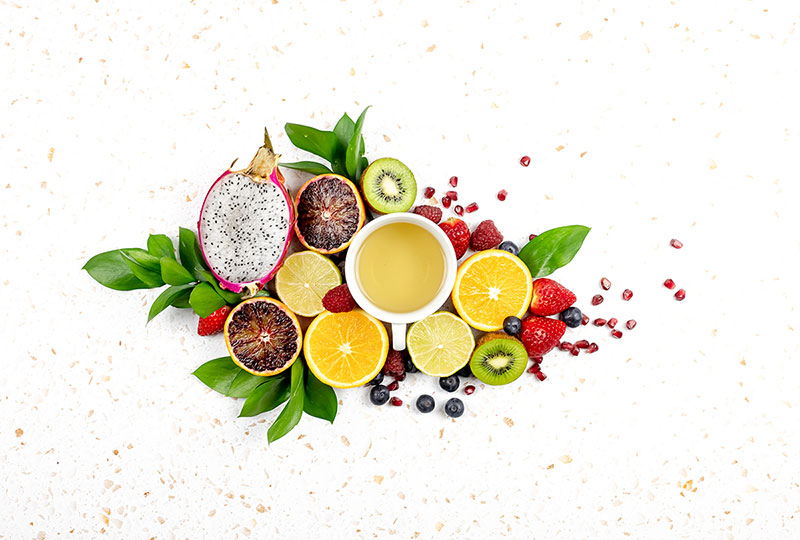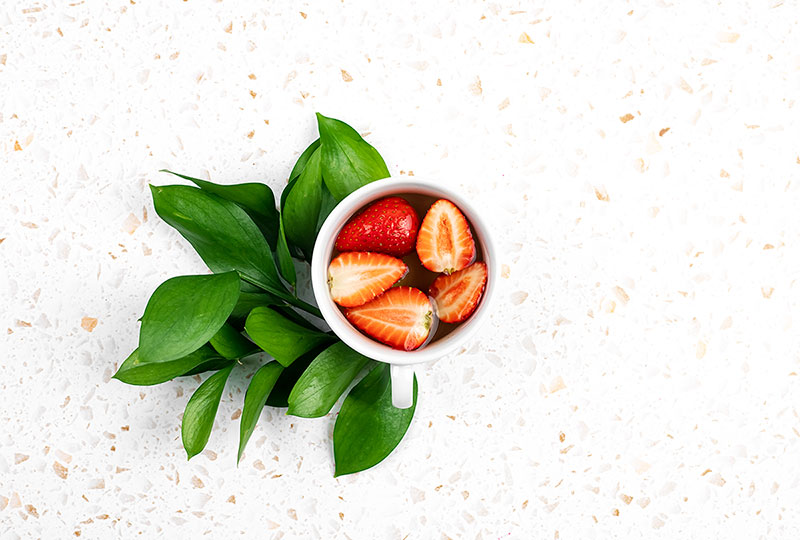Best Tea and Fruit Pairings
A cup of tea goes well with almost anything, that’s something every tea lover would agree on. But it may go especially well with fruits. Regardless if you only want a enjoy a bit of fresh fruit with your cuppa, or make tea parties with fruit salads, or even add extra fruit in your tea while steeping – there will be a perfect fruit for every tea. Learn which teas and fruits make the best pairs.
What fruits go well with tea?
Many fruits will go well with tea, but some types of fruit will match some types of tea better than others. Late spring and early summer are perfect seasons to experiment with tea and fruit pairing and add a dose of fresh sweetness into your cuppa. The main reason for adding fresh fruits to your tea is to enjoy a healthier cup without additives or refined sugar, but still bursting with flavor and sweetness.
Although many teas will taste great blended with tea leaves, some may flavors may be better than others. Why? Because some fruits may either have a too delicate flavor, some may not be suitable for adding to tea at all, and some may be too strong for delicate tea leaves. For example, adding fresh banana while steeping is not the best way to add banana flavor because your tea will become murky. Opt for dried pieces instead. Strong pineapple flavor may be too much for delicate silver needle and sour kiwi may not go so well with black tea with chocolate notes.
The best fruits you can add to your tea are:
- Lemons
- Strawberries
- Peaches
- Apricots
- Apples
- Blueberries
- Raspberries
- Mango
- Blood oranges
- Oranges
- Pineapple
- Plums
- Pears
- Cherries
- Passion fruit
- Mulberries
- Grapefruit
You can add dried fruits as well:
- Banana slices
- Coconut shreds
- Dried papaya chunks
- Raisins
Heighten the Fruity Flavor of your tea
Each tea is different, and so are each and every fruit. When choosing the best fruit for your tea, make sure they are ripe. Ripe fruits will have more intense flavor. Next, if you are steeping fruits together with tea leaves, always wash them first. Some fruits should be peeled, such as kiwi, pineapple, or mango. You won’t need to peel fruits like oranges, lemons, cherries or peaches, but choosing organic ones may be a better choice. For example, if you are adding lemon sliced rather than lemon juice, organic unwaxed lemons are a healthier choice.
To get the most out of your tea and fruit pair, try to match teas and fruits with a similar flavor profile. Milkier oolongs will go better with fruits such as bananas or coconut. Dark chocolaty black tea will be amazing with dried raisins while lighter black teas with a hint of maltiness will go well with rich and sweet fruits like peaches or mangos.
To add fruit to your tea, follow these steps:
- Bring water to a boil.
- Wash and cut fruits and peel them if you need too.
- Use about 1/3 to ½ cup of fresh fruits for making a cup of tea.
- Add fruits to your cup or a teapot.
- Now add tea leaves.
- Add hot water and let it steep for 3-5 minutes.
If you are making a cup of green tea that requires lower water temperature, you may add fruits and water first, wait 1-2 minutes until the water cools down while the fruits are steeping in your cup, then add tea and let it steep for another 2-3 minutes. The longer you steep your fruits, the more flavor they will release.
White tea
White tea is the most delicate type of tea. Some white teas will have a lighter flavor, such as high grade silver needle, and others may be stronger and more suitable for steeping with tea. However, White Peony or Pai Mu Tan white tea is perfect for experimenting. It has a stronger color and flavor, with hints of hay and floral notes. Try it with pears or less sweet mango.
Read more: Best pear tea recipes
Green tea
Green tea is perfect for making cold brews or iced tea in summer. Add a few pieces of fresh fruit while cold brewing and you will get a super tasty and refreshing drink. There are a few different types of green tea, but we can divide them into fresh, grassy steamed teas like Japanese sencha or kukicha, lighter pan-fired teas like Dragon Well and stronger teas with hint of smokiness such as green teas from Yunnan, Chunmee or Gunpowder.
Japanese sencha will taste great with fresher and lighter ingredients such as strawberries or kiwi, but the Chinese sencha may be blended with even stronger and sweeter fruits. Strawberries, peaches and mangos will go well with smokier, stronger teas, while blueberries, raspberries and even dragon fruit will give a delightful note to lighter pan-fired teas. Lemon slices and pomegranate arils will enliven the flavor of stronger smoky teas like Young Hyson too.
Read more: 4 homemade strawberry tea recipes
Oolong tea
There are many types of oolong tea, but we can divide them into lighter greener types and stronger darker types. Strong dark oolong tea such as Qi Lan or Red Robe oolong will sometimes have a roasted and ripe fruit notes. Enhance it by adding plums, peaches, even ripe sweet cherries, medlar fruit, mulberries or raisins. Lighter greener oolong such as green Tie Guan Yin will go well with lighter apricots, coconut or melons.
Read more: Grapefruit tea guide
Black tea
Black tea is the strongest type of tea. Depending on its flavor profile, you may enhance it with almost any fruit. Scented earl grey bergamot tea pairs wonderful with zesty fruits such as passion fruit, oranges, lemons or even pineapple. Pair it with some lemon biscuits and you will have a wonderful treat for an afternoon tea. Smoky Assam tea will go well with strawberries and mango, while lighter Indian and Sri Lankan teas will pair perfectly with apricots, pears and peaches.
Read more: Peach tea beneifts
Can’t get enough of fruity tea?
Fruit and tea make a great pair indeed, but if you want to enjoy only fruit flavors, there is a wide range of pure fruity teas available too. You can brew them hot or cold, or use them for making sweet and refreshing iced teas or even fruity desserts with tea flavored creams. Find out what are the best fruity loose leaf teas here.




